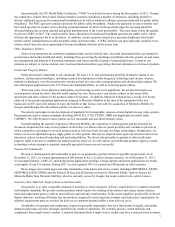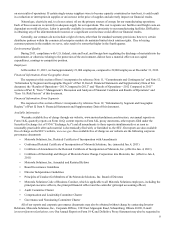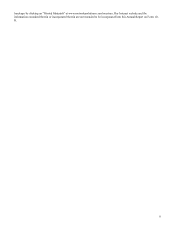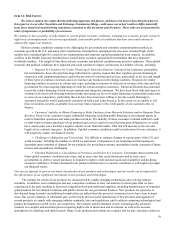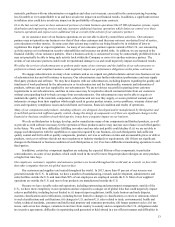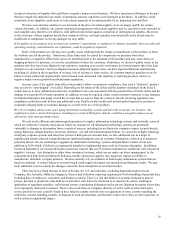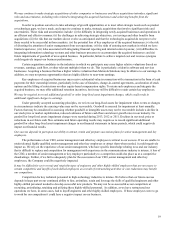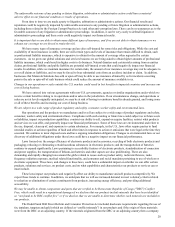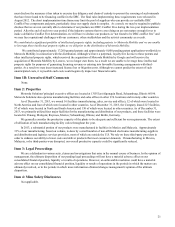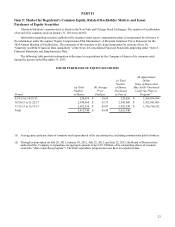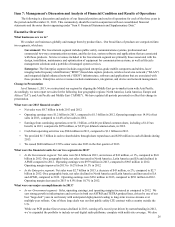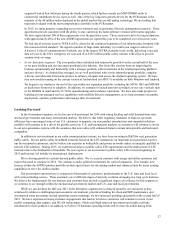Motorola 2013 Annual Report Download - page 19
Download and view the complete annual report
Please find page 19 of the 2013 Motorola annual report below. You can navigate through the pages in the report by either clicking on the pages listed below, or by using the keyword search tool below to find specific information within the annual report.17
We face many risks relating to intellectual property rights.
Our business will be harmed if: (i) we, our customers and/or our suppliers are found to have infringed intellectual
property rights of third-parties, (ii) the intellectual property indemnities in our supplier agreements are inadequate to cover
damages and losses due to infringement of third-party intellectual property rights by supplier products, (iii) we are required to
provide broad intellectual property indemnities to our customers, (iv) our intellectual property protection is inadequate to
protect against threats of misappropriation from internal or external sources or otherwise inadequate to protect our proprietary
rights, or (v) our competitors negotiate significantly more favorable terms for licensed intellectual property. We may be harmed
if we are forced to make publicly available, under the relevant open-source licenses, certain internally developed software-
related intellectual property as a result of either our use of open-source software code or the use of third-party software that
contains open-source code.
Since our products are comprised of complex technology, much of which we acquire from suppliers through the
purchase of components or licensing of software, we are often involved in or impacted by assertions, including both requests
for licenses and litigation, regarding patent and other intellectual property rights. Third-parties have asserted, and in the future
may assert, intellectual property infringement claims against us and against our customers and suppliers. These assertions
against us, and our customers and suppliers have been increasing as the complexity of our products has increased. Many of
these assertions are brought by non-practicing entities whose principle business model is to secure patent licensing-based
revenue from product manufacturing companies. The patent holders often make broad and sweeping claims regarding the
applicability of their patents to our products, seeking a percentage of sales as licenses fees, seeking injunctions to pressure us
into taking a license, or a combination thereof. Defending claims may be expensive and divert the time and efforts of our
management and employees. Increasingly, third-parties have sought broad injunctive relief which could limit our ability to sell
our products in the U.S. or elsewhere with intellectual property subject to the claims. If we do not succeed in any such
litigation, we could be required to expend significant resources to pay damages, develop non-infringing products or to obtain
licenses to the intellectual property that is the subject of such litigation, each of which could have a negative impact on our
financial results. However, we cannot be certain that any such licenses, if available at all, will be available to us on
commercially reasonable terms. In some cases, we might be forced to stop delivering certain products if we or our customer or
supplier are subject to a final injunction.
We attempt to negotiate favorable intellectual property indemnities with our suppliers for infringement of third-party
intellectual property rights. However, there is no assurance that we will be successful in our negotiations or that a supplier's
indemnity will cover all damages and losses suffered by us and our customers due to the infringing products or that a supplier
will choose to accept a license or modify or replace its products with non-infringing products which would otherwise mitigate
such damages and losses. Further, we may not be able to participate in intellectual property litigation involving a supplier and
may not be able to influence any ultimate resolution or outcome that may negatively impact our sales if a court enters an
injunction that enjoins the supplier's products or if the International Trade Commission issues an exclusionary order that blocks
our products from importation into the U.S. Intellectual property disputes involving our suppliers have resulted in our
involvement in International Trade Commission proceedings from time to time. These proceedings are costly and entail the risk
that we will be subjected to a ban on the importation of our products into the U.S. solely as a result of our use of a supplier's
components.
In addition, our customers increasingly demand that we indemnify them broadly from all damages and losses resulting
from intellectual property litigation against them. These demands stem from the increasing trend of the non-practicing entities
that engage in patent enforcement and litigation targeting the end users of our products. End users are targeted so the non-
practicing entities can seek royalties and litigation judgments in proportion to the value of the use of our products, rather than
in proportion to the cost of our products. Such demands can amount to many times the selling price of our products.
Our patent and other intellectual property rights are important competitive tools and may generate income under license
agreements. We regard our intellectual property as proprietary and attempt to protect it with patents, copyrights, trademarks,
trade secret laws, confidentiality agreements and other methods. We also generally restrict access to and distribution of our
proprietary information. Despite these precautions, it may be possible for a third-party to obtain and use our proprietary
information or develop similar technology independently. In addition, effective patent, copyright, trademark and trade secret
protection may be unavailable or limited in certain foreign countries. Unauthorized use of our intellectual property rights by
third-parties and the cost of any litigation necessary to enforce our intellectual property rights could have a negative impact on
our financial results.
As we expand our business, including through acquisitions, and compete with new competitors in new markets, the
breadth and strength of our intellectual property portfolio in those new areas may not be as developed as in our longer-standing
businesses. This may expose us to a heightened risk of litigation and other challenges from competitors in these new markets.
Further, competitors may be able to negotiate significantly more favorable terms for licensed intellectual property than we are
able to, which puts them at a competitive advantage. As our products become more like commercial products, through the
adoption of industry-standard technologies, for instance, our intellectual property-related risks may increase.


